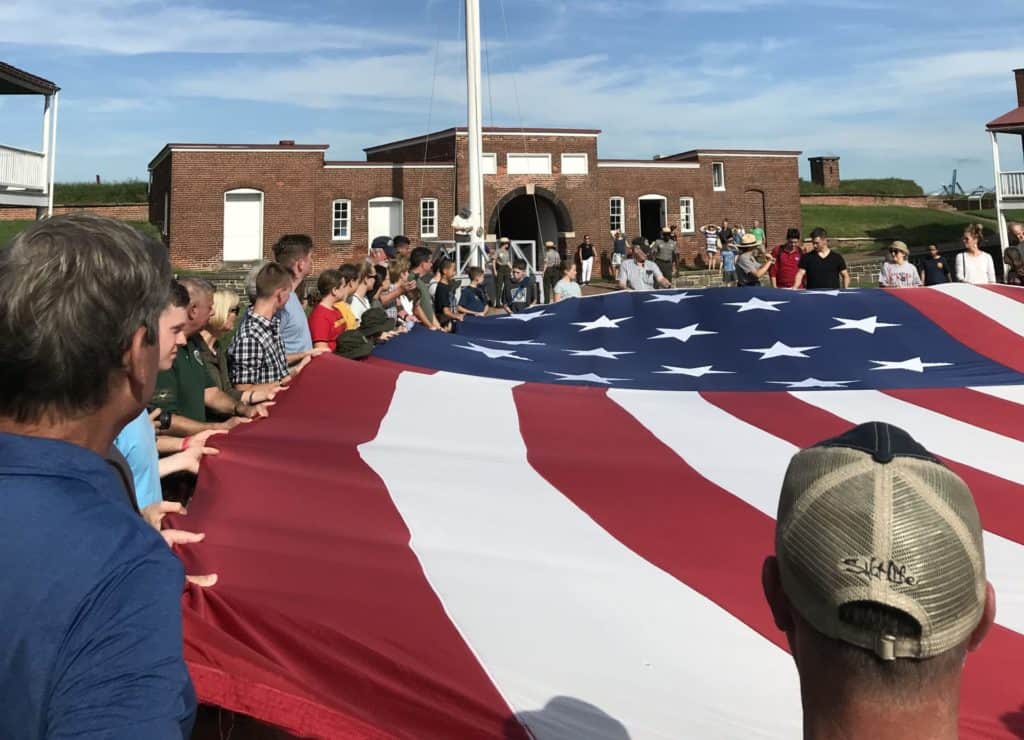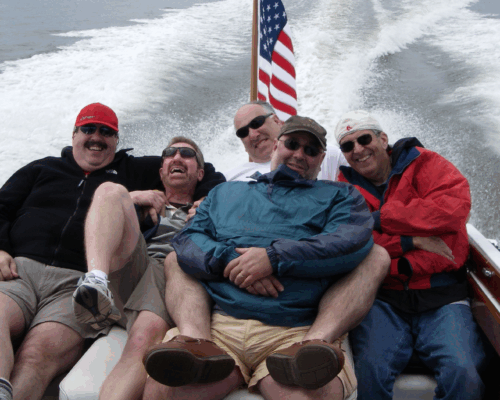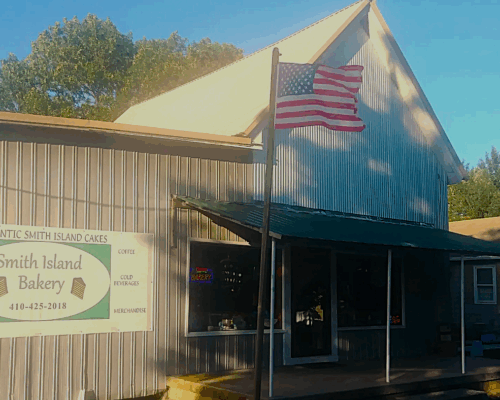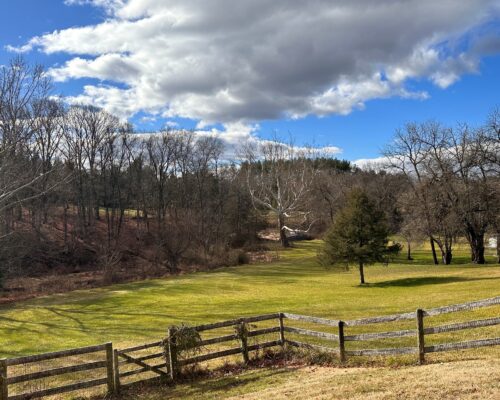Baltimore knew it had a target on its back. On August 24, 1814, British troops set fire to the White House, Capitol, and other buildings in the burgeoning city of Washington, D.C. Baltimore residents stared from their rooftops in horror at the fiery glow on the southwest horizon. Was this their future? British sailors had been seen taking depth measurements and assessing the Baltimore harbor and Fort McHenry: research for a possible attack. Baltimore was America’s third largest city and its bustling shipyards churned out fast schooners—sailing ships called privateers that captured and disrupted British shipping to the tune of millions of dollars.
The day after the British burned Washington, Baltimore’s city council called an emergency meeting. If the British showed up, should they surrender without a fight or defend the city? Would the British occupy it or burn it? What action would preserve their community and livelihoods? Those calling for defense won the argument.
They asked General Samuel Smith (also a U.S. Senator) to take command of the defense operations. He had been leading Baltimore’s preparations for several years, and predicted a two-pronged British attack, by land and by sea.
North Point State Park
The obvious starting point for a land attack was North Point, 15 miles by road from Baltimore. It allowed large ships close access and was out of range of Fort McHenry’s guns. You can begin your own campaign at North Point State Park. Walk out on the 1,000-foot long Crystal Pier to see a splendid view of the broad expanse of the Chesapeake, close to the spot where the attack began.
Shortly after noon on Sunday, September 11, 1814, a white flag appeared over the Ridgely house (no longer standing) nearby. Lookouts on Federal Hill in Baltimore knew this meant that observers on the Bay had spotted British ships heading toward Baltimore. They went into action. Three cannon booms pierced the silence and the streets filled with chaos.
Soon, an armada of 50 Royal Navy ships filled the water around North Point. At around 3 a.m. on September 12, the still night erupted with activity. About 4,700 British soldiers disembarked from warships onto the sandy soil at North Point. The invasion had begun. (The closest you can get to the unloading point is the adjacent Fort Howard Park at the point extending into the Patapsco River).
Follow Old North Point Road toward Baltimore as it curves over tidal creeks and through farmland. Watch for several interpretive markers along the way. Soon, commercial development crowds into the bucolic landscape, requiring more of your imagination.
North Point State Battlefield & Battle Acre Park
The Patapsco Neck peninsula you’re standing on varied in width from a few hundred yards to 2 or 3 miles. Its narrowest point, a half-mile stretch of land between waterways, acted as a funnel. It was a strategic location and the site of the opening battle to take Baltimore. This park preserves nine acres where much of the fighting occurred, and is meant to evoke the terrain as it was when the British met with Baltimore’s defenders. On the land nearby, British General Robert Ross had suddenly slumped over in his saddle, the victim of American sharpshooters. While the truth is uncertain, local lore credits the shot to either Daniel Wells or Henry G. McComas, two teenage leather-working apprentices and Army privates, both of whom are alleged to have taken the shot, and both of whom died in the subsequent skirmish. There is a monument to Baltimore’s “boy heroes” in the city’s Old Town neighborhood. The Americans held their ground, but eventually retreated, pulling the British to the main American defenses on Hampstead Hill.
Patterson Park
When the British troops reached the base of the hill, they stopped. Today, Patterson Park preserves some of Hampstead Hill, site of the American defensive line guarding the eastern approach by road to the city. Here, the Americans built an extensive system of trenches and gun batteries, part of a ring which surrounded much of the city. The hill and defenses proved daunting to British generals and stopped the land attack. The park was founded in 1827, the first land given for public recreation and the oldest park in Baltimore. Look for the iconic pagoda, which dates to 1891 and is flanked by a row of historic cannons. The cannons—of the sort, if not the actual guns that were used to repel the British—are a mishmash of countries and dates of origin; one made by the Dutch East India Company dates to the 1680s, another was cast in England under George I.
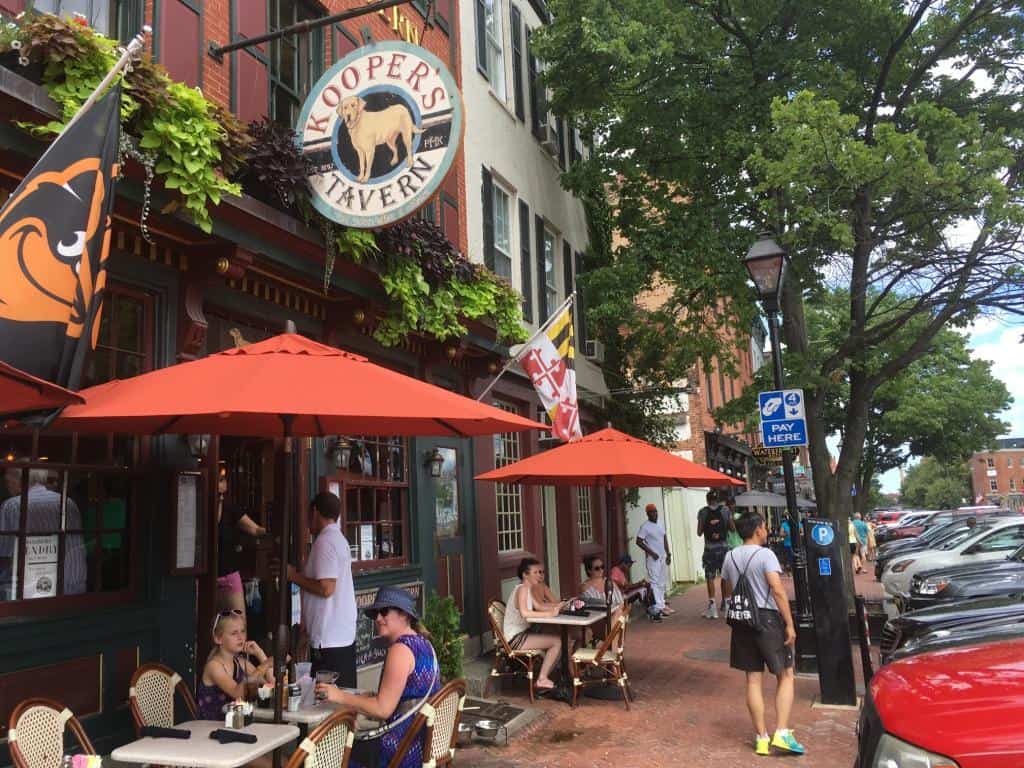
Fells Point
Baltimore’s reputation as a center for privateering earned it scorn from the British and was the primary reason for their attack. Though its shipyards are long gone, Fells Point retains a maritime flavor, with streets made of old Belgian block ships’ ballast and lined with narrow rowhouses. Visiting tall ships often dock at the foot of Broadway, which is also a Baltimore Water Taxi stop. (As of this writing, the taxi’s operations are changeable due to COVID-19, but normally you can catch a boat out to Fort McHenry from here.) A park at the end of Thames Street, which runs along the water, celebrates Isaac Myers, who set up a collective, Black-owned shipyard in the area, and Frederick Douglass, who worked as a ship caulker while enslaved here.
The most famous ship made at Fells Point was Chasseur, dubbed “the Pride of Baltimore,” which became famous during the War of 1812 for taking the fight to the British. Today, a reproduction of that ship, Pride of Baltimore II, in most years offers tours and cruises and serves as a worldwide ambassador for the Port of Baltimore. It is sometimes docked in Fells Point. Restaurant openings are in flux due to the pandemic and quickly changing regulations, but if you’re looking for a thematically appropriate lunch stop, The Horse You Came In On Saloon (thehorsebaltimore.com) has been in continuous operation since 1775, and offers burgers and pub fare.
Star Spangled Banner Flag House
A few blocks away, in today’s Little Italy neighborhood, sits a narrow brick house. The star-spangled story really begins one year earlier, in 1813, when officials from Fort McHenry stopped by the shop of flagmaker Mary Pickersgill and placed an order for two large flags to fly over the fort. A savvy businesswoman, Mary completed the order with the help of her daughter, nieces, mother, an indentured servant, and an enslaved girl. Step inside the small house and you immediately see why the large flag, with its 42-foot-long stripes, had to be completed in the larger space of a nearby brewery. The original receipt on display in the museum shows Pickersgill earned $574.44 (roughly $8,800 today). She never dreamed her flag would one day be a national treasure, preserved in the Smithsonian and the focus of the US national anthem.
Battle Monument
Less than a mile away stands America’s first significant war memorial. The 39-foot-tall column supports a female figure representing the city of Baltimore. It honors all 39 men who died during the battle. The cornerstone was laid less than a year after the attack, though the monument was not completed until 1825. An image of the monument appears on the city’s flag. It’s a few blocks out of the way, but consider including a visit to the Wells and McComas Monument and waving hello to the boy heroes, apocryphal or not, as you pass.
Samuel Smith Grave
If you have a few extra minutes, visit General (and Senator and Mayor and Congressman—he did it all) Samuel Smith’s grave in Westminster Hall and Burying Ground (near Edgar Allen Poe’s grave). His funeral procession was the largest Baltimore had ever seen and included all the nation’s top leaders, even the president. The burying ground opened in 1787, and is resting place to many prominent early Baltimoreans and heroes of the Revolutionary and 1812 wars. The gothic revival church came later, in 1852, and was built over some of the existing graves, raised on brick and stone piers to preserve them.
Fort McHenry
At the crack of dawn on September 13, five British bomb ships and one rocket ship moved into position just out of range of Fort McHenry’s guns. The star-shaped brick fort was the focus of the British sea attack. In a ferocious 26-hour bombardment, the British navy lobbed roughly 1,500 rockets, shells, and cannonballs at the structure (some estimates are much higher). Early on September 14, the sight of Mary Pickersgill’s huge flag waving over the fort proved the British had not succeeded in their attack and inspired Francis Scott Key to pen the words of what would become America’s national anthem. Owned by the American people and maintained by the National Park Service, Fort McHenry features a visitor center with excellent exhibitions and a film. The well-preserved fort offers all ages an adventure of exploration. It’s easy to imagine the incoming bombs, and on calm days, you might see a massive flag flying on the fort’s flag pole. If you’re there at day’s end, you might be invited to help take down the flag.
Federal Hill
Backtracking a bit from the Fort, Federal Hill overlooks the Inner Harbor, and takes its name from being the site of a 1789 celebration of the signing of the Constitution. Joshua Barney, a Revolutionary War hero who would go on to command the Chesapeake Flotilla in the War of 1812, came up with the celebration’s centerpiece, a 15-foot, square-rigged ship named Federalist, which Barney then sailed to Mount Vernon and presented to George Washington. A statue of Samuel Smith, the defender of Baltimore, gazes out over the city. It was here that lookouts saw the white flag at North Point in the distance and swung into action. Nervous residents watched the bombardment unfold from the surrounding rooftops. And here cannons boomed to celebrate the treaty of peace that came the following February. You can’t access them, but the hill is riddled with tunnels, some used for quarrying clay, others for Civil War storage, and one allegedly dug for Barney himself to store ammunition for privateers during the War of 1812. It was also the site of a gun battery to protect against the British which, for reasons discovered at Fort McHenry, went unused.
The neighborhood of Federal Hill, just to the west of the hill itself, is young, vibrant, and full of restaurants and bars. It’s a great place to end your journey with a meal.

